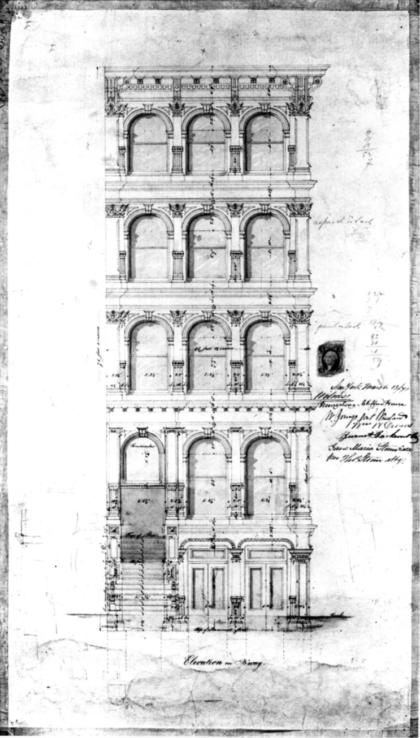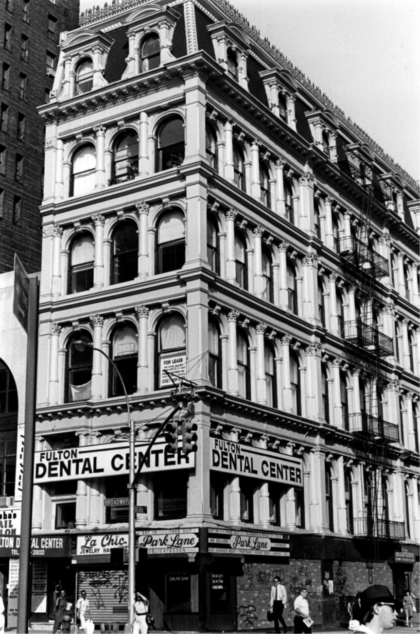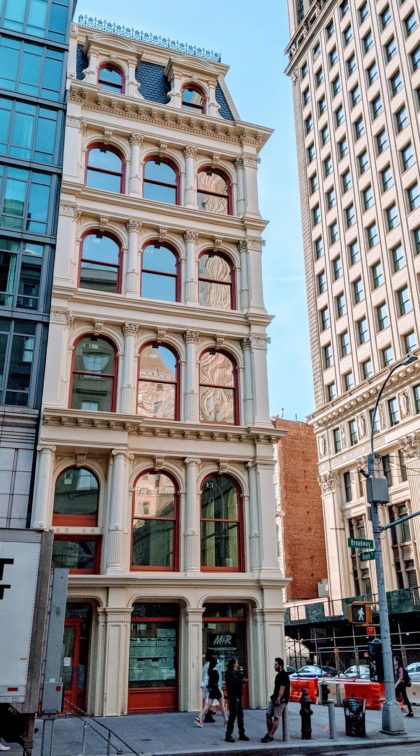Proposal to add 287 Broadway to the register of historic places
The former leaning tower of Tribeca, aka 287 Broadway, was added to the city’s list of landmarks in 1989, and now Gov. Kathy Hochul is including it in her list of 36 recommendations for the State and National Registers of Historic Places. And since I never added Tom Miller’s (always excellent) post on the building, this seemed like a good time to do it. So here goes:
Just after the Civil War, the French Second Empire style of architecture, all the rage in Paris, caught on in New York City. The style that Walt Disney would later make synonymous with Victorian architecture insisted on a mansard roof and endowed the buildings with instant fashion and elegance. The lavish Gilsey Hotel, Lord & Taylor’s grand emporium at 19th and Broadway, and the A.T. Stewart department store all arose from the Second Empire bandwagon.
Architect John B. Snook followed the trend when he designed the prestigious office building at No. 287 Broadway in 1871 for the estate of Stephen Storm, who had been an important wholesale grocer and tobacco seller. Intended as a bank on the lower level with offices above, it would have one of the first Otis elevators in the city.
Snook’s cast iron façade spilled over with sophistication and class. The steep, slate-shingled mansard was punctuated by robust dormers with arched pediments, and the roofline was edged in filigree cast iron cresting. Completed in 1872, the narrow building extended down Reade Street 96 feet.
The impressive new building attracted prominent tenants like the Union and Pacific Railroad Company and attorney to the wealthy, Otto Horwitz. The bank offices were one floor above the sidewalk, accessed by a flight of steps, probably cast iron, at the far left of the Broadway façade. On the first floor, in 1885, was the pharmacy of Ernest Washburne.
After closing the drugstore one January night that year, Washburne stopped at Niblo’s Garden, a popular theater, with some friends. After the performance, he strolled about alone. It was apparently a bad idea.
The druggist ran into Mary Moran, described by The New York Times as “a vulgar, frowsy-looking creature,” who asked him to buy her a drink at a nearby saloon. Later, when Washburne paid for the drinks, Mary got a good look at his cash.
The pair left the saloon together and, upon reaching the corner of West 3rd Street and Wooster, the woman threw her arms around Washburne, rendering him helpless as a male accomplice relieved him of $50, his watch and gold chain, and a diamond stud. Unfortunately for Mary, who had some years previously stolen $57,000 in cash in her grandest heist, Washburne’s description was clear. She was arrested soon after.
Mary Moran was sentenced to 10 years in the penitentiary. Ernest Washburne became more wary of his drinking companions.
The insurance firm Traders and Travelers’ Accident Company had their offices upstairs at 287 in 1887. As World War I neared, the banking floor was home to the Henry Bischoff Banking House, while Henry Bischoff & Co., a shipping and forwarding company which “does forwarding for both importers and exporters, sells steamship tickets, and in a small way acts as a private bank,” occupied offices on the fourth floor.
Henry Bischoff had come to the U.S. in 1846 from Germany and established his banking and shipping companies. After Bischoff died on March 28, 1913, things went downhill. In January 1914 lawsuits were filed against the firm for overcharging for forwarding and shipping and a several claims which the company could not meet. The company failed and was put into receivership.
A month later the bank was declared bankrupt.
Almost a century later, the first floor space once occupied by Ernest Washburne was now a pizza parlor and the exterior staircase to the former banking floor was gone. But the elegant cast iron structure still retained its integrity. Trouble came when all the buildings around it were razed for a planned 20-story condominium project by the John Buck Company of Chicago.
The excavations for the foundation of the new building went deeper and deeper and, unnoticed at first, the landmarked building on the corner began tilting. Cracks appeared. And then, when the structure was leaning a full 8 inches to the south, the tilt was obvious to anyone passing by.
In November 2007 the building was ordered evacuated and heavy shoring was installed to keep it from collapsing.
Four years later the glass-and-steel “reade57” building was completed, wrapping around and dwarfing it’s vintage neighbor. Today No. 287 Broadway is secure again, its appearance above the street level remarkably intact and unchanged since 1871.
TC post-script: The building has come full circle now that a bank is once again a tenant. TD Bank took the ground floor space there in 2023. The building now has 10 apartments, which were available as of 2018.
And a bit extra from the designation report:
The cast-iron facades on both Broadway and Reade Street feature large round-arched windows separated by Ionic columns at the second story and by Corinthian above, each story crowned by a cornice. The high mansard roof, topped by lacy iron cresting, retains its original slate shingles and is pierced by dormers with segmental pediments and round-arched windows.
This building graphically illustrates the transformation of lower Broadway in the 19th century from a residential boulevard into the city’s commercial center. The unparalleled growth of New York City in the 19th century, which led to its emergence as the largest and richest city in the country, was primarily the result of commerce. Following the War of 1812 and the reopening of the Atlantic trade routes, and the completion in 1825 of the Erie Canal, which connected New York to the interior, the city grew into the country’s major port and trading center. Commercial pressures almost immediately began to push the city northward beyond the geographical limits of lower Manhattan, and a pattern of rapid development and redevelopment emerged.
The city’s commercial districts moved into former residential areas, replacing older houses with first-class shops, while new residential districts for the wealthy developed still further north on the city’s outskirts. Older prime commercial areas to the south became warehouse and wholesale districts. Following the completion in 1846 of the precedent-setting A.T. Stewart dry goods store at 280 Broadway, designed by Joseph Trench and John B. Snook, the section of Broadway north of City Hall rapidly changed into the city’s leading connnercial district. Stewart’s store, an impressive stone Italianate-style “palazzo” with cast-iron and glass storefronts, also established the architectural character for much of that development for the rest of the century.
Ihe site of the 287 Broadway building contained a dwelling and carriage house as early as 1794, awned by attorney William Alexander. By the time Elbert Anderson bought the house in 1816, the southern end of the block already contained stores; Anderson demolished the house in 1818 and the following year erected a commercial building. Stephen Storm purchased the property as an investment in 1821. Storm, a sixth-generation descendant of Dutch settlers, was alternately a wholesale grocer and tobacco merchant.
In the 1840s the buildings on the west side of Broadway near Chambers Street were replaced by two 50-foot wide buildings. Stephen Storm and the other three owners of property on the west side of Broadway retained the titles to the land and buildings and combined them in 1848-49 to form the Irving House Hotel. Famous guests included Swedish singer Jenny Lind in 1850 and Hungarian patriot Louis Kossuth in 1851.
Snook (1815-1901) was born in London, and came to New York as a child of 2, where he was educated in private schools. Trench & Snook is credited with the design of the first A. T. Stewart Store (1845-46) across the street from 287 Broadway at the corner of Broadway and Chambers Street, now the Sun Building, a designated New York City landmark. Dubbed the white marble palace, it was the first Italianate structure in New York City. Snook’s impressive career, spanning the second half of the nineteenth century, included some 500 buildings.






















In the 1990’s and even before that I used to visit my artist friend Cora Cohen there. She had the whole 5th floor and divided into living quarters and a big studio. Climbing the stairs to get there was, er, exhilarating. I wonder what happened to Mr. Otis’ elevator? Cora was forced to move out when the construction next door threatened the building. She moved to Astoria Queens and had a separate studio in Manhattan and continued to paint until the end. Alas she unexpectedly died last year.